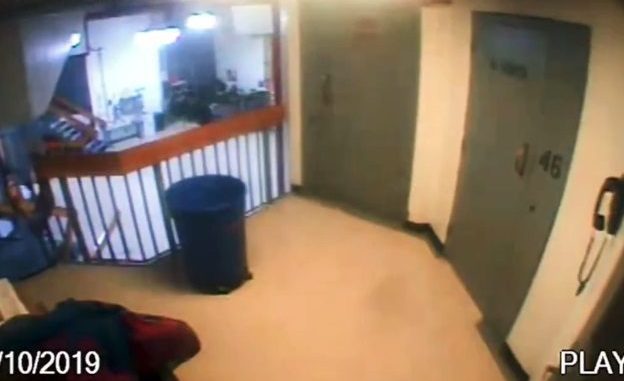
Published July 12, 2025
The controversy surrounding Jeffrey Epstein’s mysterious 2019 death in federal custody has reignited with new intensity following the release of forensic analyses of a long-awaited prison surveillance video. Experts say the footage released by the Department of Justice (DOJ) earlier this month bears troubling signs of manipulation, potentially reigniting long-standing suspicions that Epstein’s death was more than just a “suicide.”
A Long-Delayed Release with Serious Red Flags
The DOJ’s Office of the Inspector General finally released raw footage from outside Epstein’s cell in Manhattan’s Metropolitan Correctional Center (MCC). But what was meant to offer closure only deepened the mystery.
According to metadata analysis and forensic reviews detailed in reports from RedState, The Gateway Pundit, and Wired, experts noted that the prison video bears clear signs of having been altered or reconstructed — including suspicious timestamp anomalies, changes in compression artifacts, and discrepancies in file structure that indicate possible post-production editing.
Digital forensics expert Gary Galbraith, who examined the metadata, observed that the “raw” video had been re-encoded multiple times, using software such as Adobe Premiere Pro, strongly suggesting that the footage had been opened and possibly edited before being released. In his words, “There is no way this is untouched surveillance footage. Someone went in and did work on this.”
What the Metadata Reveals
Metadata from the video shows export dates and software not typically associated with raw surveillance files. For example:
-
The video’s encoding history reveals multiple saves and modifications.
-
Timestamps do not match the expected timeline for surveillance systems — particularly those used in federal detention centers.
-
Portions of the footage appear to have been stitched together, possibly to eliminate content or obscure visual details from key moments on the night of Epstein’s death.
These discrepancies are not just technicalities; they raise serious questions about the integrity of evidence related to one of the most controversial custodial deaths in recent memory.
Axios reported:
President Trump‘s Justice Department and FBI have concluded they have no evidence that convicted sex offender and disgraced financier Jeffrey Epstein blackmailed powerful figures, kept a “client list” or was murdered, according to a memo detailing the findings obtained by Axios.
- The administration is releasing a video — in both raw and “enhanced” versions — that it says indicates no one entered the area of the Manhattan prison where Epstein was held the night he died in 2019.
- The video supports a medical examiner’s finding that Epstein died by suicide, the two-page memo claims.
Why it matters: The findings represent the first time Trump’s administration has officially contradicted conspiracy theories about Epstein’s activities and his death — theories that had been pushed by the FBI’s top two officials before Trump appointed them to the bureau.
- As social media influencers and activists, Kash Patel (now the FBI’s director) and Dan Bongino (now deputy director) were among those in MAGA world who questioned the official version of how Epstein died.
- Patel and Bongino have since said Epstein killed himself. But it has become an article of faith online, especially on the right, that Epstein’s crimes also implicated government officials, celebrities and business leaders — and that someone killed him to conceal them.
- The memo says no one else involved in the Epstein case will be charged. (Epstein’s associate Ghislaine Maxwell is serving a 20-year sentence for child sex trafficking and related offenses.)
A Pattern of Inconsistency
This isn’t the first time the DOJ and Bureau of Prisons have been accused of mishandling or altering evidence in the Epstein case.
-
In 2019, officials claimed surveillance footage from the first Epstein suicide attempt was “accidentally deleted.”
-
Two prison guards who failed to monitor Epstein the night of his death admitted to falsifying records.
-
And now, even with the release of this long-sought footage, the public is left with a video that fails to provide transparency — and instead fuels further speculation.
Wired’s Take: Not Just Fringe Theories
Even Wired, a mainstream tech outlet typically cautious with conspiracy-adjacent stories, acknowledges the inconsistencies. Their analysis aligns with independent forensic experts who insist the video doesn’t reflect typical surveillance footage. The use of editing software and anomalies in export history are consistent with video modification, not just routine formatting.
While Wired doesn’t draw firm conclusions, it raises key questions: Why did it take so long to release this footage? Who accessed and edited the file? And what exactly might be missing?
🔁 Resulting Effects:
1. Erosion of Public Trust in Institutions
The DOJ’s release of apparently edited video footage fuels public skepticism toward federal institutions — particularly the Department of Justice, the Bureau of Prisons, and the FBI. This incident reinforces the perception that key government agencies are either incompetent, deceptive, or both when handling politically sensitive cases.
2. Renewed Interest in Epstein’s Network
Far from putting the case to rest, the suspicious video reawakens public interest in Epstein’s powerful connections — from Wall Street billionaires to global political elites. The notion that someone may have “helped” silence him, and that evidence may have been covered up, keeps conspiracy theories alive and growing.
3. Bipartisan Outrage
Unlike many political scandals, the Epstein case has provoked outrage across party lines. Whether from left-leaning voices demanding accountability or right-leaning watchdogs warning of deep-state corruption, the tampered video reinforces the idea that elites are protected by a different standard of justice.
4. Pressure for Congressional Oversight
Members of Congress may now face pressure to reopen investigations into Epstein’s death and the overall handling of his case. Calls for subpoenas, hearings, or independent reviews could grow louder, especially from lawmakers already critical of DOJ transparency.
5. Further Undermining of the Official Suicide Narrative
Forensic evidence of video tampering casts further doubt on the already controversial “suicide” determination. The idea that Epstein took his own life while both guards were asleep, cameras malfunctioned, and jail protocols broke down is now even harder to sell — and easier to question.
6. Amplification in Independent Media
Alternative and independent media outlets are already running with the story, digging into metadata and drawing attention to inconsistencies. This expands the reach of the Epstein story outside of mainstream narratives and contributes to the growing distrust of legacy news outlets that initially dismissed doubts as “conspiracy.”
7. Legal and Ethical Concerns for the DOJ
If it’s proven that officials knowingly released edited video under the pretense of transparency, there could be legal ramifications. Even if not criminal, the ethical questions alone could spark internal investigations, watchdog complaints, and future legal challenges.
 Bottom Line:
Bottom Line:
The release of Jeffrey Epstein’s prison surveillance video was expected to provide long-awaited transparency. Instead, it has deepened the mystery. Forensic evidence of video modification — from altered metadata to signs of post-production editing — raises alarming questions not just about Epstein’s death, but about institutional integrity at the highest levels.
What should have been a moment of clarity has only reinforced public suspicion: that someone, somewhere, doesn’t want the full truth revealed. Until there is an honest accounting of how this video was handled — and why it appears to have been tampered with — the Epstein case will remain a symbol of unanswered questions, institutional mistrust, and justice deferred.





Be the first to comment